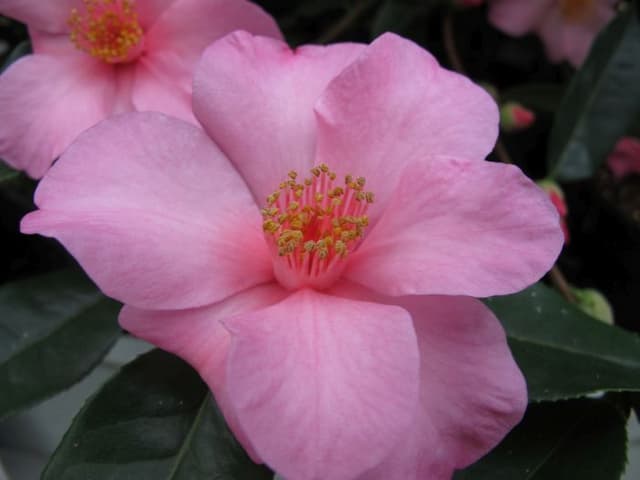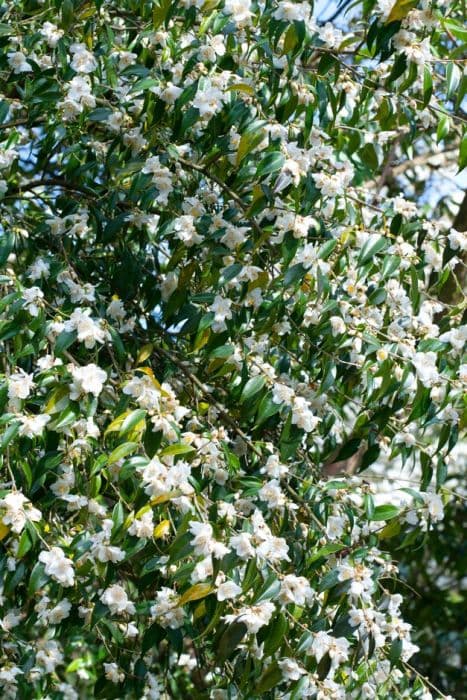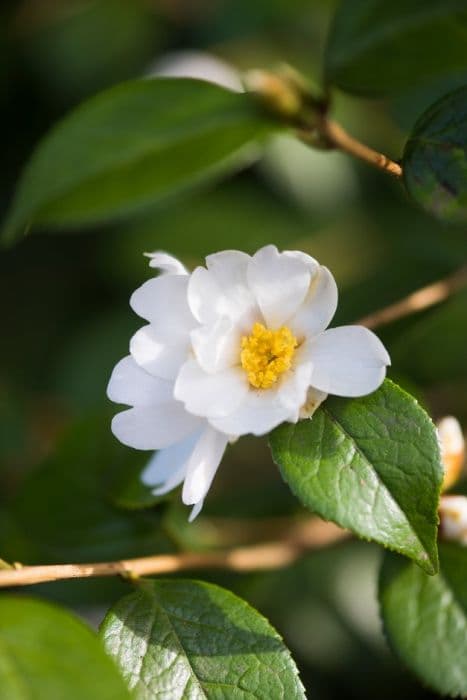Japanese camellia Camellia japonica 'Doctor Tinsley'

ABOUT
The Camellia japonica 'Doctor Tinsley' is a plant that displays a luxurious floral presence and an elegant foliage charm. The flowers are a standout feature, with their delicate appearance that often sports a blend of soft pink petals with deeper pink stripes or shading. The petals have a unique, somewhat ruffled look that adds texture and depth to the blooms, making them look full and substantial. Each flower traditionally showcases a central cluster of golden-yellow stamens, which provide a lovely contrast to the pink petals and attract the attention of pollinators. The leaves of 'Doctor Tinsley' are dark green, glossy, and leathery, providing a perfect backdrop for the blooms. The foliage is typically evergreen, meaning the leaves stay on the plant year-round, contributing to its status as a cherished ornamental shrub. The leaves are oval-shaped with slightly serrated edges, and they can give the plant a dense, lush appearance that is both aesthetically pleasing and beneficial for providing privacy in garden settings. Overall, the Camellia japonica 'Doctor Tinsley' is admired for its showy, attractive flowers and its handsome, verdant foliage, which together create a picturesque display in any garden that favors their cultivation conditions.
About this plant
 Names
NamesFamily
Theaceae
Synonyms
Japanese Camellia, Rose of Winter
Common names
Camellia japonica 'Dr Tinsley'.
 Toxicity
ToxicityTo humans
Camellia japonica, commonly known as Japanese camellia, is not considered toxic to humans. There are no widespread reports of poisoning or adverse health reactions associated with the ingestion of Camellia japonica in humans. Therefore, accidental ingestion of the Japanese camellia plant is not likely to cause harm.
To pets
Japanese camellia is also generally considered non-toxic to pets. There is no significant evidence to suggest that ingestion of Camellia japonica 'Doctor Tinsley' or other varieties of Japanese camellia causes poisoning in pets such as dogs and cats. Consequently, pets are not expected to experience toxic effects from consuming this plant. However, it's always advisable to prevent pets from eating non-food plants since individual reactions can vary and gastrointestinal irritation is possible.
 Characteristics
CharacteristicsLife cycle
Perennials
Foliage type
Evergreen
Color of leaves
Dark green
Flower color
Pink
Height
6-10 feet (1.8-3 meters)
Spread
5-7 feet (1.5-2.1 meters)
Plant type
Shrub
Hardiness zones
7-9
Native area
Japan
Benefits
 General Benefits
General Benefits- Ornamental Appeal: The plant features beautiful, delicate pink flowers that add aesthetic value to gardens and landscapes.
- Habitat Support: Can provide nectar and pollen for bees and other pollinating insects, supporting local ecosystems.
- Shade Tolerance: Thrives in partial shade, making it suitable for planting under trees or in shaded garden spots.
- Evergreen Foliage: Maintains green leaves throughout the year, offering continual visual interest even when not in bloom.
- Soil Erosion Control: The roots help stabilize soil, reducing the risk of erosion in the garden.
- Cultural Significance: Often used in traditional and celebratory plantings in certain cultures; a symbol of spring.
- Low Maintenance: Requires minimal pruning and care once established, suitable for gardeners of all skill levels.
- Long Blooming Period: Offers prolonged blooming from late winter to early spring, when few other plants flower.
- Versatility: Can be used in various landscape designs, including formal gardens, borders, and as specimen plants.
- Privacy Screen: When planted in a series, can form a dense screen that adds privacy to outdoor spaces.
 Medical Properties
Medical PropertiesThis plant is not used for medical purposes.
 Air-purifying Qualities
Air-purifying QualitiesThis plant is not specifically known for air purifying qualities.
 Other Uses
Other Uses- The leaves of the Camellia japonica 'Doctor Tinsley' can be utilized for crafting due to their sturdy nature and glossy finish when preserved.
- Because of its dense foliage, it can serve as a natural privacy screen or hedge in gardens and landscapes.
- The bloom's petals can be used to create natural dyes for fabric and paper, giving them a delicate pink hue.
- The plant can also be trained to grow in unique forms, such as espaliers, which can be used as ornamental features on garden walls.
- Dried camellia petals can be incorporated into potpourri mixtures, adding color and a light fragrance to the mix.
- When camellia blooms fade, they can be added to compost heaps as a source of organic matter that will break down and enrich garden soil.
- The wood from pruned branches can be fashioned into small woodworking projects like utensils or decorative items due to its smooth grain.
- Floral artists can use camellia flowers in corsages and boutonnieres as they hold up well when cut and do not wilt quickly.
- Fallen camellia petals can be gathered and floated in bowls of water as a simple yet elegant decorative element for events or home décor.
- Culinary enthusiasts sometimes use the brilliant camellia flowers as stunning, yet non-toxic garnishes on special dishes and desserts.
Interesting Facts
 Feng Shui
Feng ShuiCamellia is not used in Feng Shui practice.
 Zodiac Sign Compitability
Zodiac Sign CompitabilityCamellia is not used in astrology practice.
 Plant Symbolism
Plant Symbolism- Adoration: The camellia flower often represents deep admiration for someone's qualities. 'Doctor Tinsley' radiates respect and adoration through its delicate petals.
- Perfection and Excellence: With its flawless form and symmetry, the camellia is a symbol of perfection and the pursuit of excellence, which could be linked to the meticulous care it requires to thrive.
- Longevity: Camellias are known for their long blooming season and longevity, symbolizing a wish for a long and healthy life.
- Love and Affection: The lush, full blooms of the camellia are often associated with genuine love and affection, conveying heartfelt emotion.
- Divine Beauty: The sheer beauty of the camellia bloom is thought to symbolize the divine or a reflection of heavenly beauty here on earth.
 Water
WaterFor the Japanese Camellia 'Doctor Tinsley,' consistency is key, so water the plant deeply but infrequently to keep the soil moist. During the growing season, water the plant with approximately 1-2 gallons per week, adjusting this amount during periods of rainfall or drought. In winter, reduce watering to when the soil feels dry to the touch. Always avoid letting the soil dry out completely, as camellias are sensitive to drought. Ensure that water reaches the roots by watering at the base of the plant to promote deep root growth.
 Light
LightJapanese Camellia 'Doctor Tinsley' thrives in partial shade with some morning sun and afternoon protection from the intense sun rays. An ideal spot for planting is under high canopies of trees that provide dappled sunlight. Avoid exposure to full afternoon sun which can cause scorching of the leaves.
 Temperature
TemperatureJapanese Camellia 'Doctor Tinsley' prefers temperatures between 60°F and 80°F for optimal growth. It can tolerate minimum temperatures down to 20°F but should be protected from cold winds and frost. A site with consistent temperatures avoiding fluctuations especially in winter is ideal for this plant.
 Pruning
PruningPrune Japanese Camellia 'Doctor Tinsley' to maintain its shape, remove dead or damaged wood, and encourage vigorous growth. The best time to prune is just after the flowers have faded in spring but before new growth begins. Thin out dense areas to allow light and air to reach the center of the plant. Pruning every year or two is sufficient unless shaping is required more frequently.
 Cleaning
CleaningAs needed
 Soil
SoilThe Japanese Camellia 'Doctor Tinsley' thrives in well-draining, acidic soil with a pH between 5.5 to 6.5. A good soil mix for this camellia can be a blend of equal parts compost-rich peat, pine bark, and perlite or sand to ensure proper drainage and aeration.
 Repotting
RepottingCamellias, including the 'Doctor Tinsley', generally need repotting every 2-3 years. It's best to repot in the spring before the growing season begins.
 Humidity & Misting
Humidity & MistingJapanese Camellia 'Doctor Tinsley' prefers high humidity levels, generally above 50%. Avoid placing in areas with dry air or near heat sources which reduce humidity.
 Suitable locations
Suitable locationsIndoor
Keep near a bright window, avoid direct sunlight.
Outdoor
Plant in partial shade, shelter from strong winds.
Hardiness zone
7-9 USDA
 Life cycle
Life cycleThe Camellia japonica 'Doctor Tinsley', commonly known as the Japanese Camellia, begins its life as a seed, typically germinating in spring after a period of stratification. The seedling stage involves the emergence of the first leaves and root system, which is followed by the juvenile phase where the plant experiences vegetative growth and develops its characteristic glossy, evergreen leaves. As the plant matures into an adult, it enters the flowering stage, which typically occurs in late winter to early spring, showcasing its large, ornamental pink flowers with delicately ruffled petals and contrasting yellow stamens. After pollination, often by bees, the flowers develop into seed pods that, when mature, open to release seeds for dispersal. The plant continues to grow and can live for many years, entering a cycle of dormancy during colder months and resuming growth in the warmer seasons. Throughout its life, the Japanese Camellia requires care and favorable conditions, such as well-drained acidic soil and partial shade, to maintain its health and vibrant blooms.
 Propogation
PropogationPropogation time
Spring-Early Summer
The most popular method of propagating Camellia japonica 'Doctor Tinsley', often simply known as the Japanese camellia, is through semi-hardwood cuttings. This method is typically done in late summer after the new growth has matured and begun to harden. To propagate by cuttings, a gardener would select a healthy, non-flowering stem and cut a 4 to 6-inch (about 10 to 15 cm) length, making the cut just below a node. The lower leaves are removed, and the cut end can be dipped in rooting hormone to encourage root development. The cutting is then placed in a well-draining potting mix, ensuring that the node where the leaves were removed is beneath the soil surface. The pot should be kept in a warm place with indirect light and the soil should be kept consistently moist but not soggy. With proper care, the cutting will root and can eventually be transplanted outdoors.









